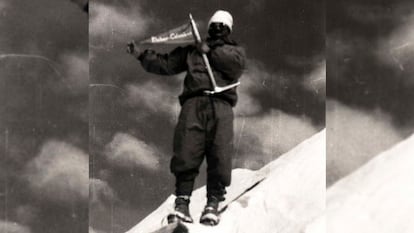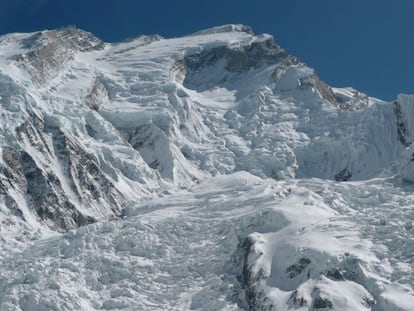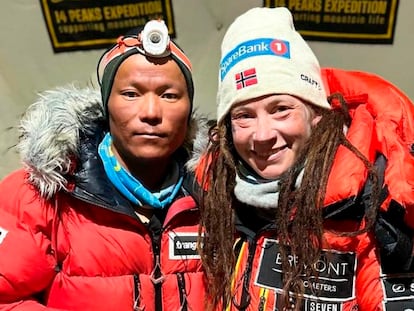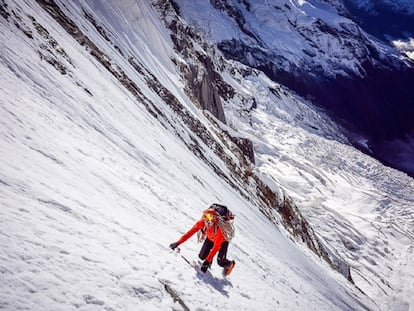Annapurna, 1950: The warlike and deceitful account of the first ascent of an eight-thousander
It has been 75 years since the pioneering summit, narrated by Maurice Herzog, whose account hides his fanaticism and nationalist motivations and trivializes mountaineering as a mere battle against the natural environment

On June 3, France celebrated the 75th anniversary of the conquest of Annapurna (8,091 meters), the first mountain standing over 8,000 meters to be climbed by humans. Some French media outlets devoted articles to the event throughout the preceding week: little wonder, since so much literature has emerged about a heroic feat that the passage of time has eroded into a rather bleak serial. That day in 1950, Maurice Herzog urged his companion Louis Lachenal to take photographs of him on the summit, one after another, snapshots that would go around the world. However, Lachenal refused to pose for posterity: he just wanted to descend at once, to regain the warmth in his feet, which already felt numb. In the only (out-of-focus) image preserved, he is seen cowering in the snow, like a dog waiting for its master’s signal to leave.
But Lachenal was no dog: he was the most respected, fastest, and brilliant mountaineer of the time. He was an accomplished high-altitude guide, while Herzog was merely an amateur with a mission: to narrate the conquest. Along with Lachenal, the great mountaineers Lionel Terray and Gaston Rébuffat signed up, so eager to experience another great adventure that they agreed without hesitation to a condition that would define an era: only Herzog could tell the story of Annapurna. They didn’t care. They just wanted to climb. Herzog made up for his lack of pedigree with Lachenal’s infallible presence and with enormous doses of fanatical recklessness: the person in charge of the story couldn’t miss the summit, the glory. Thus, on the morning of June 3, two men with opposing wills took turns blazing a trail to the summit. Very soon, Lachenal realized that if he continued, he would lose his feet, and his feet represented his life as a climber. He asked Herzog what he would do if he gave up. His response was that of a fanatic on an evangelical mission. “I’ll continue alone,” he declared. Lachenal was a man who respected the codes of the mountains, the sacred bonds of the rope team, and he knew that if he turned back, his partner would never return: he lacked the skill and was possessed of too much madness. Every step up the slope was a curse for Lachenal’s feet: he hadn’t felt them for hours.

The descent was even worse: the fog engulfed them, they hesitated, and Lachenal unleashed his inhuman instinct. Finally, they found help from Terray and Rébuffat: “My feet, get me down from here now. I need the doctor’s help,” Lachenal pleaded of his close friend Terray. Lost again in the clouds, the four spent a night at the bottom of a crevasse, chewing on their misfortune. Herzog, who had misplaced his gloves, would also lose all his fingers. The worst of nightmares was confirmed in Lachenal’s case; all his toes were amputated. An iconic photo captured his misfortune: on his return from Nepal, he stepped off the plane in Terray’s arms, just a sack of skin and bones, aged by suffering, his blunt feet bandaged in nuclear white. He was 28 years old.
A year later, Herzog published Annapurna: First Conquest of an 8000-meter Peak, the official account of the expedition. It sold more than 20 million copies and was translated into 60 different languages. Herzog was seen as a hero and became a minister under Charles de Gaulle and mayor of Chamonix. Lachenal is blurred in the account, like his blurred photo on the summit. It is arguably the absolute classic of mountain literature, the work that recruited the most mountaineers to the cause, a true dream factory. In fact, the book’s profits funded many subsequent French expeditions.
The exclusivity of the expedition’s account expired in 1955, just as Lachenal was working on a book reviewing his career and settling accounts of what happened on Annapurna. But he wouldn’t see it in print. While skiing in the Vallee Blanche, Lachenal fell to the bottom of a crevasse and died. His manuscript would be published later, in 1956, but censored by Herzog, and it wouldn’t be until 2020, when Paulsen Editions recovered the complete work in Rappels, that his full account would come to light.
But before that, at the beginning of the 21st century, rumors grew. Did they really reach the summit, or did they sign a pact of silence about it — a lie? The summit photo Herzog presented doesn’t look like one and could have been taken anywhere. Recently, studies using satellite imagery and comparisons with confirmed summit photographs have revealed that Lachenal and Herzog reached the summit, although this is not an isolated peak, but rather a long ridge of nearly 300 meters with two or three almost identical peaks.
In his work, Lachenal makes it clear that he is alienated from anything related to the prevailing nationalism of the time, from France’s need to regain a certain prestige on the international stage after the shame of World War II. If Herzog longed for a photo op at the summit, Lachenal prioritizes the mountaineer’s eye, his obligation to return home in one piece, as if it were a climb in Chamonix. The mountain is not a place to wave flags. Nor a factory of would-be heroes. The mountain has nothing to do with heroes or failures. It is not a political or social springboard. It should not systematically involve a struggle between heads and tails.
Herzog’s story is deceitful and disguises with manipulated sentiments a warlike discourse that would permeate for decades and become the official narrative of almost all expeditions to climb the 14 eight-thousanders: man against mountain, the assault on impossible peaks, vanity, victory, testosterone, the supposed brotherhood of mountaineers. It’s a fanatical narrative that pales in comparison today: it’s no longer a matter of climb or die, but rather climb to live. “The greatest failure of a mountaineer is not to return home,” maintains the great American climber Steve House. The rest is simply literature.
Sign up for our weekly newsletter to get more English-language news coverage from EL PAÍS USA Edition
Tu suscripción se está usando en otro dispositivo
¿Quieres añadir otro usuario a tu suscripción?
Si continúas leyendo en este dispositivo, no se podrá leer en el otro.
FlechaTu suscripción se está usando en otro dispositivo y solo puedes acceder a EL PAÍS desde un dispositivo a la vez.
Si quieres compartir tu cuenta, cambia tu suscripción a la modalidad Premium, así podrás añadir otro usuario. Cada uno accederá con su propia cuenta de email, lo que os permitirá personalizar vuestra experiencia en EL PAÍS.
¿Tienes una suscripción de empresa? Accede aquí para contratar más cuentas.
En el caso de no saber quién está usando tu cuenta, te recomendamos cambiar tu contraseña aquí.
Si decides continuar compartiendo tu cuenta, este mensaje se mostrará en tu dispositivo y en el de la otra persona que está usando tu cuenta de forma indefinida, afectando a tu experiencia de lectura. Puedes consultar aquí los términos y condiciones de la suscripción digital.
More information
Archived In
Últimas noticias
Most viewed
- Sinaloa Cartel war is taking its toll on Los Chapitos
- Oona Chaplin: ‘I told James Cameron that I was living in a treehouse and starting a permaculture project with a friend’
- Reinhard Genzel, Nobel laureate in physics: ‘One-minute videos will never give you the truth’
- Why the price of coffee has skyrocketed: from Brazilian plantations to specialty coffee houses
- Silver prices are going crazy: This is what’s fueling the rally











































